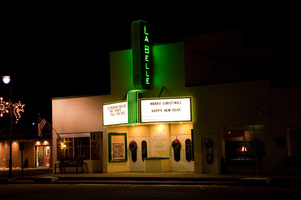 | Back to e-WV
| Back to e-WV
 The West Virginia Encyclopedia
The West Virginia Encyclopedia
 | Back to e-WV
| Back to e-WV
 The West Virginia Encyclopedia
The West Virginia Encyclopedia

South Charleston, located on the Kanawha River adjoining Charleston to the southwest, rose with the development of the chemical industry in the early 1900s.
South Charleston occupies a historic location along a buffalo trail that became the James River & Kanawha Turnpike, later known as the Midland Trail. An Adena burial mound, the second largest in West Virginia, is more than 2,000 years old. In the 1800s, stagecoaches stopped at the mouth of Davis Creek, and travelers favored the dependable spring for which the South Charleston neighborhood of Spring Hill is named.
In 1827, James Blaine built a gristmill on Blaine Island, in the Kanawha River near the present downtown. For years the area remained mostly undeveloped, however, overshadowed by its larger neighbor across the river. That changed in 1906, when former Gov. William A. MacCorkle founded the Kanawha Land Company, buying with other investors 1,800 acres on the south side of Kanawha River. Civil engineers laid out an orderly grid of streets, and the new town was named South Charleston.
In 1907, the town founders induced Banner Glass Company to relocate from Indiana. About 40 families, mostly Belgian and French, came to work at the glass factory. Other factories followed, lured by cheap coal, natural gas, and salt, and by easy access to rail, highways, and the Kanawha River.
During World War I, the town boomed as demand for chemicals and other war products grew. The federal government broke ground for the huge Naval Ordnance Plant, but the war was over by the time the plant produced its first steel in February 1921. The plant has since been put to a variety of military and civilian uses. By 1919, South Charleston had grown to more than 3,000 residents, and the state legislature officially made it a town.
The company that made South Charleston a center of industry was Union Carbide, which bought up property along the Kanawha River in 1925. ‘‘Carbide,’’ as it was called locally, grew into one of the world’s largest chemical companies, and for the next three-quarters of a century the fortunes of the company and the city were intertwined. Starting in 1949, Union Carbide developed its technical center above its South Charleston plant. The facility drew highly educated scientists from all over the world.
At its height, Union Carbide employed approximately 10,000 people in the area, and South Charleston’s population peaked at 19,180 in 1960. But changing markets in the 1980s and the tragic industrial accident at its Bhopal, India, facility in 1984 undercut the company’s future. The Dow Chemical Company acquired Union Carbide in 2001 and substantially reduced employment.
With large cuts in chemical and manufacturing jobs, South Charleston has moved to diversify its economy. In the late 1990s, the city worked with developers to bring many stores to the Southridge area, which soon became the region’s main shopping district. It built the area’s only ice skating rink near the shopping center and several soccer fields. South Charleston is served by Thomas Memorial Hospital, which was founded in 1946 and provides health services to a wide region. The South Charleston Recreation Center opened in 1982 with an indoor pool, basketball court, racquetball courts, and weight rooms.
In 2020, South Charleston’s population was 13,639, making it West Virginia’s 11th largest city.
Written by Scott Finn